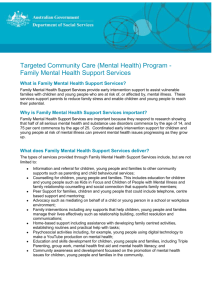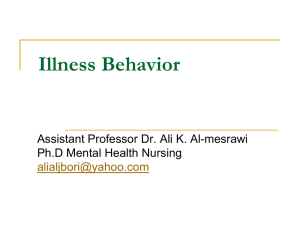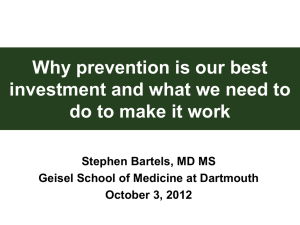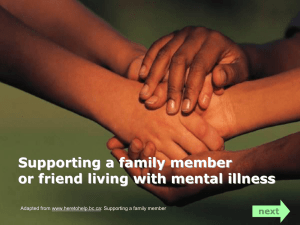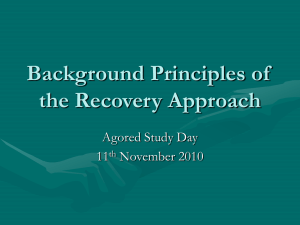Empowerment & Recovery in Mental Illness - NAMI-NC
advertisement
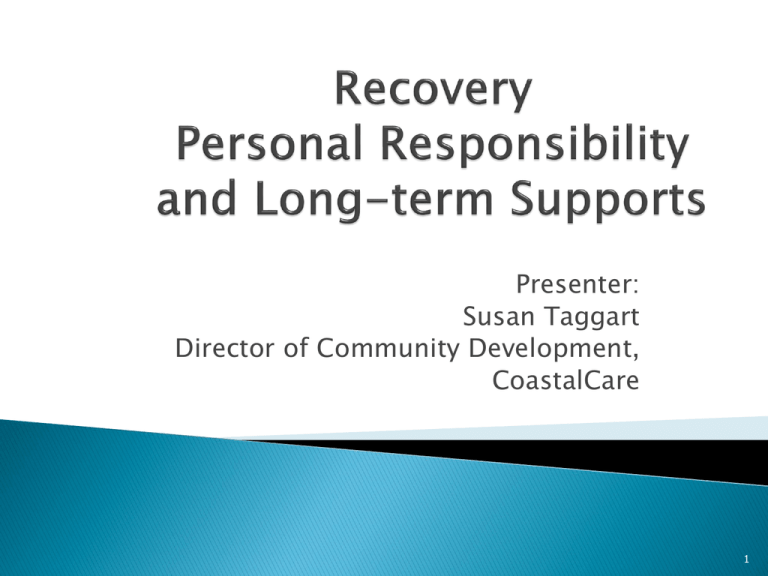
Presenter: Susan Taggart Director of Community Development, CoastalCare 1 Recovery Personal Responsibility/Illness Management Long-term Recovery Support Systems 2 The Recovery-Oriented Systems of Care (ROSCs) are designed to help individuals recover from behavioral health problems across their lifespan. ROSCs provide free and independent choices across an array of treatment and recovery support options. 3 The emerging model of recovery care recognizes that a systems approach is required. Coordinated support services are necessary using a chronic care model of sustained recovery management. 4 Treatment: Counseling (individual or group) and other behavioral therapies. Medication Management Self-Management of Illness/Education Social Connectedness 5 Self-Direction Strengths-Based Individualized Peer Support Empowerment Respect Holistic Responsibility Non-Linear Hope SAMHSA Consensus Statement on Mental Health Recovery Feb 2006 http://www.samhsa.gov/news/newsreleases/060215_consumer.htm 6 Post-treatment monitoring and support, Long-term recovery-oriented (and stage appropriate) recovery education, Peer-based recovery coaching, Linkage to communities of recovery, and Re-intervention when necessary. 7 All require a solid support system while they build upon their strengths in recovery. 8 Loss of Sense of Self Loss of Connectedness ◦ Guilt ◦ Shame ◦ Isolation Loss of Power Loss of Valued Role Loss of Hope Spaniol et al 1999 9 Values & Beliefs Person Work 10 Reclaiming responsibility for one’s own life. The achievement of better health. The development of purpose, fulfillment, happiness and usefulness that everyone seeks. The reconnection with personal dreams and passions. The realization of one’s inner potential. 11 Community coalitions are alliances of people representing diverse organizations that work together to achieve a common goal. Effective coalitions combine the resources of multiple organizations and individuals to convey a strong message. Widespread support achieved by coalitions helps educate a broader audience that mental and/or substance use disorders affect all people. 12 Identify motivated people to lead the development of a local steering committee. Identify the various target groups and skills. Look for key community members such as county commissioners, local business people, people with disabilities, NMAI, AA, NA, local public agencies, etc. 13 Knowledge (illness) ILLNESS (deficit management) Consumer-directed centers Develop their own programs to supplement existing mental health services, Address issues such as social isolation and discrimination, Enjoy opportunities for socialization, personal and educational enhancement, and peer support. 15 A central place for consumer self-help, advocacy, education and socialization. Provides a socialization service that addresses the isolation felt by many people with disabilities. They are open to all people with needs. No admission fee or membership fee is charged. 16 Various recovery-oriented activities Peer counseling Self-help and Illness Management Education and training WRAP®: Wellness Recovery Action Plan®. Click here for more information on WRAP®. Advocacy Social clubs Outside social activities Artistic endeavors Life Skills and General Education Business Management Fund Raising 17 Select a treatment program that offers a variety of continuing care services Find a recovery support group and stay actively involved with it. Involve your family members in family support groups and activities. If your home environment is not conducive to continuing recovery, investigate moving. Recognize that you need to become an expert on your own illness and/or addiction, and take responsibility for it. Learn techniques and strategies to help you maintain your recovery during difficult or challenging times. Learn how to manage the tendency toward negative thinking. Use cognitive training or the help of others. Learn effective techniques to deal with conflict. 18 Knowledge which cannot or is not put into action is not empowering ! 19 FRIGHTENED ANGRY ? ? DISTRESSED ? CONFUSED ? WHAT DO YOU SEE? 20




